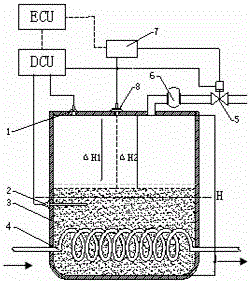Laser detection method of residual ammonia gas in solid ammonia storage system
A technology for residual ammonia and ammonia storage, applied in exhaust gas treatment, electrical components, exhaust devices, etc., can solve the problems of reduced adsorption capacity, affecting the use effect, low adsorption and desorption efficiency, etc., and achieves benefits for emission reduction, Reliability and accuracy improvement, high practical value effect
- Summary
- Abstract
- Description
- Claims
- Application Information
AI Technical Summary
Problems solved by technology
Method used
Image
Examples
Embodiment 1
[0039] Prepare a stainless steel storage tank with an effective volume of 32L, with a height of H=460mm and a diameter of 300mm. Fill the tank with 15kg of solid ammonia storage material to complete the ammonia filling; use commercially available pressure sensor 1, temperature sensor 2, and ammonia gas metering Valve 5, filter 6 and laser displacement sensor 8, according to as figure 1 , 2 , The structure shown in 3 and 4 is installed on the storage tank, and the connection between the control display and the laser displacement sensor 8 and the ECU is completed, and the connection between the ECU and the DCU and the ammonia metering valve 5 and the storage tank is completed; the antifreeze conduit, ammonia Connect the air inlet and outlet, and complete the ammonia filling; then match the system with the aging test bench of the 8.6L engine, in which the antifreeze pipe 4 is connected to the engine cooling circuit to provide a heat source; at the rated engine speed of 2100rpm, ...
Embodiment 2
[0041] Adopt the engine prepared by embodiment 1 and the ammonia storage system, at the rated engine speed of 2100rpm, the torque is 1200 Nm to continue the reliability test operation, start the ammonia release valve, after the test is carried out for 133h, the ammonia pressure that the system builds up is still 310kpa, at this time, read the distance from the probe of the laser displacement sensor to the interface of the active material, △H2=210mm, which is greater than the rated 45%H of 207mm, and the display controller is a yellow light;
Embodiment 3
[0043] Adopt the engine and the ammonia storage system after the operation of Example 2, at the rated engine speed of 2100rpm, the torque is 1200 Nm to continue the reliability test operation, start the ammonia release valve, and after the test has been carried out for 3 hours, the ammonia pressure established by the system is still It is 229kpa. At this time, read the distance from the probe of the laser displacement sensor to the interface of the active material, △H3=218mm, which is greater than the rated 47%H of 216mm, and the display controller is a red light.
PUM
 Login to View More
Login to View More Abstract
Description
Claims
Application Information
 Login to View More
Login to View More - R&D
- Intellectual Property
- Life Sciences
- Materials
- Tech Scout
- Unparalleled Data Quality
- Higher Quality Content
- 60% Fewer Hallucinations
Browse by: Latest US Patents, China's latest patents, Technical Efficacy Thesaurus, Application Domain, Technology Topic, Popular Technical Reports.
© 2025 PatSnap. All rights reserved.Legal|Privacy policy|Modern Slavery Act Transparency Statement|Sitemap|About US| Contact US: help@patsnap.com



